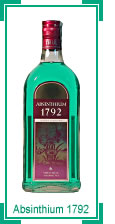It’s nice to see that Czech absinth is being enjoyed in Mexico!
TIJUANA – U.S. officials are surprised to find that absinthe, a wormwood-laced liquor banned in the United States more than 90 years ago amid concerns about its drug-like effects, is resurfacing at the border. Young adults returning from Tijuana are bringing back bottles, say customs officials who are now on the lookout for the liquor renowned in its heyday among writers and artists in bohemian Paris.
Known as la fée verte – “the green fairy” – because of its color and the hallucinations it is said to produce, absinthe is legal in Mexico and has been legalized in much of Europe over the past 10 years.
At San Ysidro, border agents started seizing bottles about a month ago and have confiscated about 30 since then, a supervisor said last week. “There was nothing a year ago,” said Chief Christine Schneider of Customs and Border Protection, who is now training border inspectors to look for the liquor. Absinthe’s effects are legendary and formed part of the plot of the 2001 blockbuster film “Moulin Rouge.” It was the rage in France 100 years ago. Writers Ernest Hemingway, Edgar Allan Poe and Oscar Wilde sang the praises of the drink. Artists Henri Toulouse-Lautrec, Edouard Manet and Pablo Picasso considered it as essential as brushes and paint for the creation of their paintings.Vincent van Gogh, it’s said, cut his ear off while using the stuff.
Absinthe, or absinth, as it’s spelled in Mexico and some parts of Europe, is highly alcoholic and made with a mixture of herbs.Mexico never banned absinthe, but it disappeared because of bans in Europe, where it was made, a distributor said. In the past few months, though, a Mexican-made version of the 110-proof liquor has reappeared in bars and liquor stores along Tijuana’s Avenida Revolución, where posters featuring a voluptuous raven-haired green fairy promise: “Your fuel for tonight . . . ”
For people who order the $8 cocktail, waiters place a sugar cube on a small strainer over a glass of ice, soak it with the green liquor, light it aflame and then mix it with cold water. The cloudy, greenish blend tastes like anisette “It’s a strong liquor,” said Roberto Lopez, a waiter at El Torito Pub, one of the bars that carries absinthe. “With two or three shots, you get real relaxed.” The bar also sells 180 ml bottles at $25 each.“People always ask if you can take it across the border,” said waitress Minda Ayala. She tells them it’s illegal in the United States, and that may be part of the appeal for U.S. tourists. “Since it’s prohibited over there, they come here and buy it,” she said. Liquor store clerks up and down the tourist strip say people ask about absinthe daily.
One liquor store on Revolución featured a bright yellow sign touting absinthe to passers-by. Inside, eight small bottles lined a shelf underneath a poster saying, “Not sold in USA. Sold Here. OK for USA Customs Border crossing.”A clerk who did not want to give his name said he was surprised by news of the border seizures. He said the store used to carry a European absinthe that sold for $145 a bottle, and buyers were curious.“They would look at it,” he said. “But they wouldn’t buy it because of the price.”
Juan Rubalcava, a Mexico City importer who markets Czech absinthe, said distribution is slowly picking up, but most of his sales – targeted at high-end drinkers – are in the country’s capital, not border towns such as Tijuana.
—And over the years, factories in the Czech Republic quietly continued to produce absinthe, as did bootleggers in Switzerland.
Then, in the 1990s, countries throughout Western Europe began legalizing absinthe while limiting the thujone content, and commercial production was resumed.
Czech producers, freed from Communist government control, began exporting their product.
And Pernod reintroduced its original formulation of absinthe, which is sold in Europe and Canada but not in the United States or Mexico. It has become a chic drink in bars in London, where it was never banned, and it’s now sold on the Internet, where some marketers say it’s not hard to get past customs. And, aside from the twin effects of alcohol and thujone, part of absinthe’s allure over the centuries is the ritual of sweetening and diluting the bitter liquor, according to a 2002 article in Modern Drunkard magazine.
“There is a certain sense of superiority that goes along with the ritual,” the magazine said. “While the peasants in the corner merely pour their booze in a glass and lap it down like wild animals, we, the smart people, the insiders in the know, are engaging in nothing less than alcoholic alchemy!”
🙂












Absinthe is no more “drug-like” than whisky or rum. I’m glad US customs lifted the ban on absinthe because there is no scientific evidence that suggests its any worse for you than any other type of spirit.